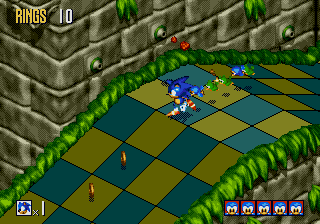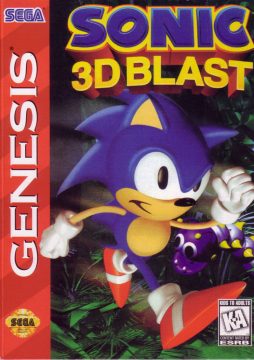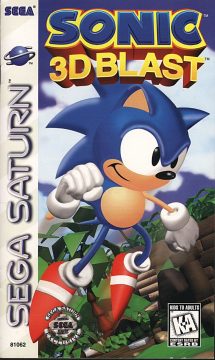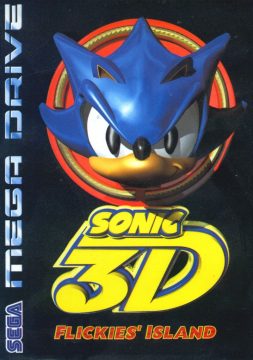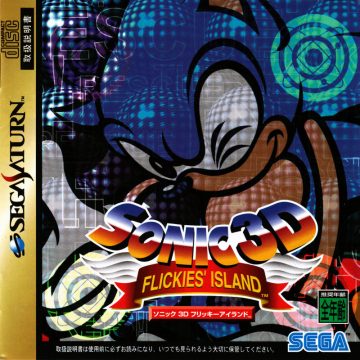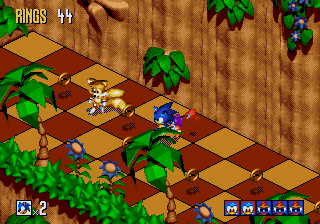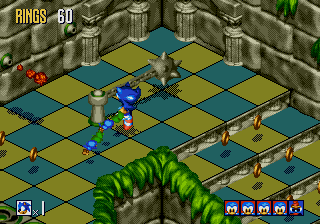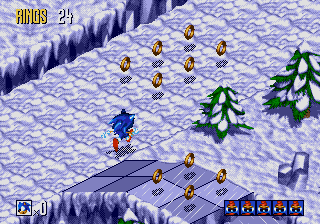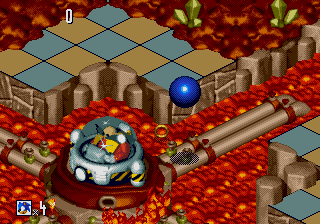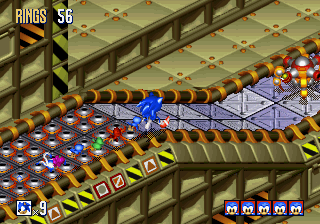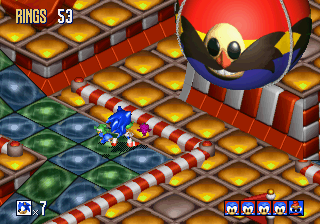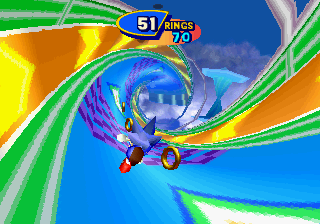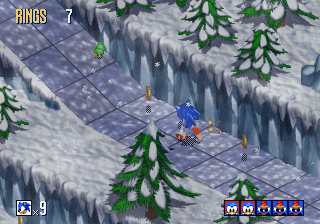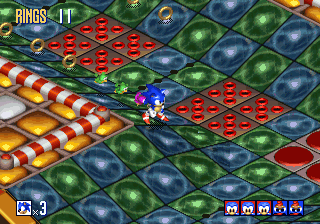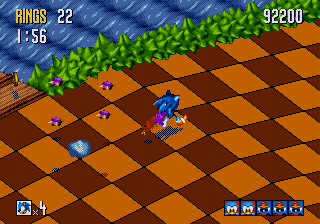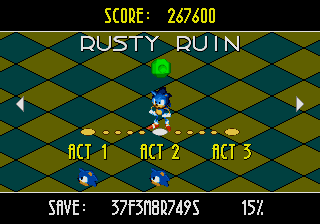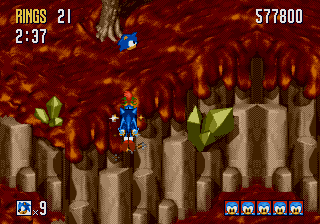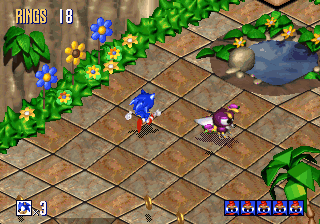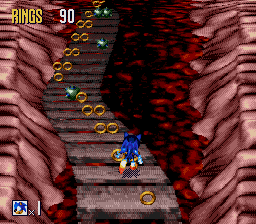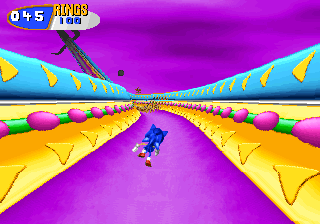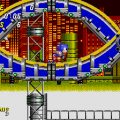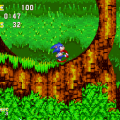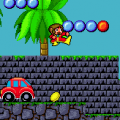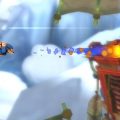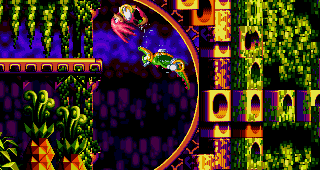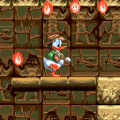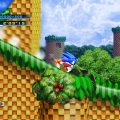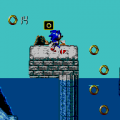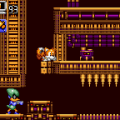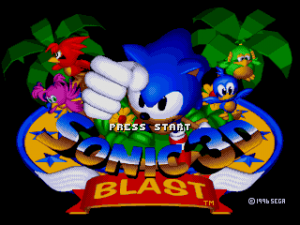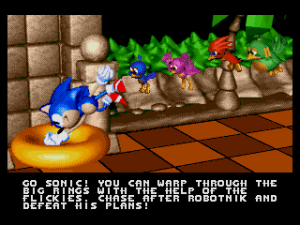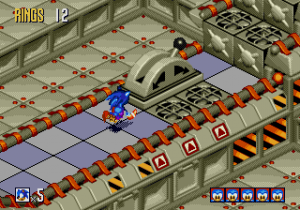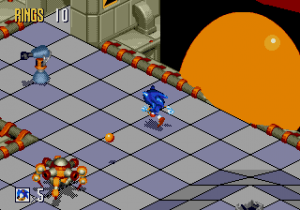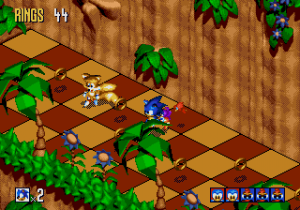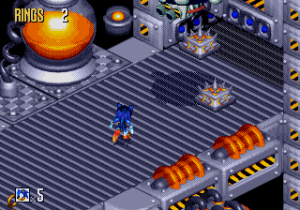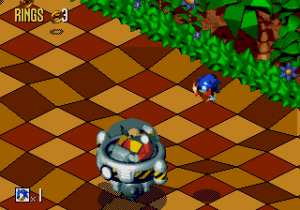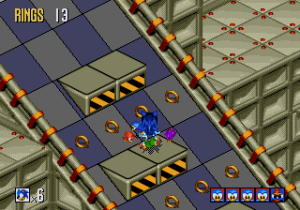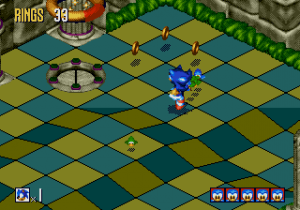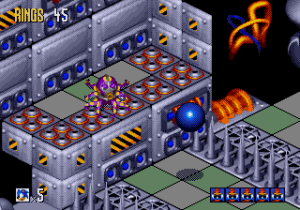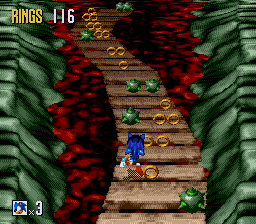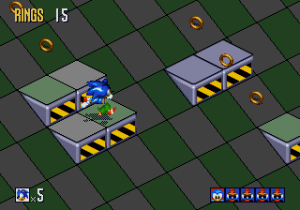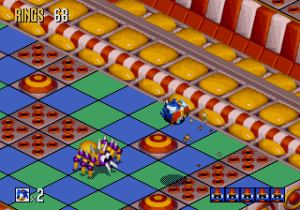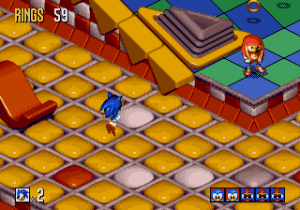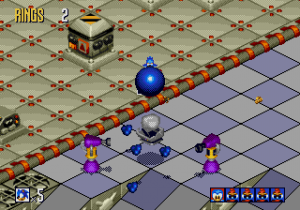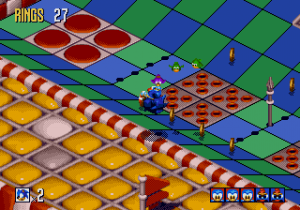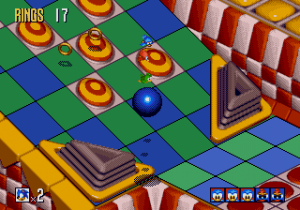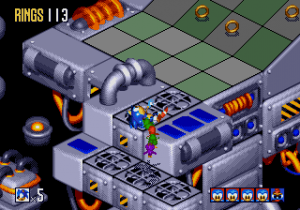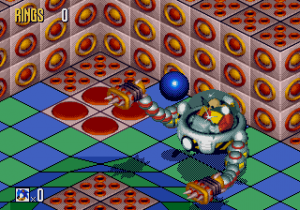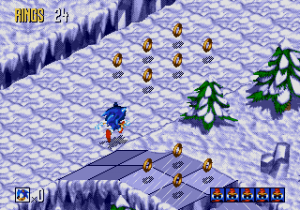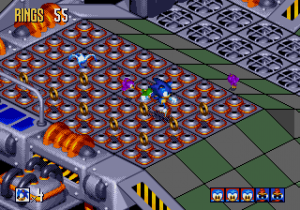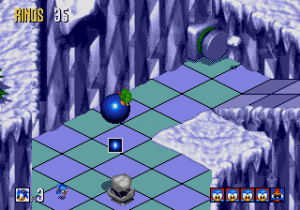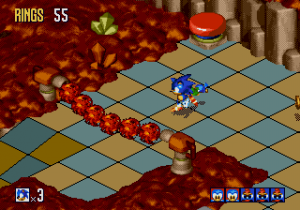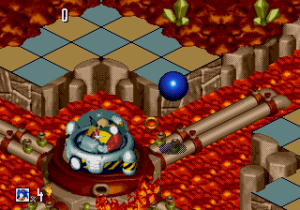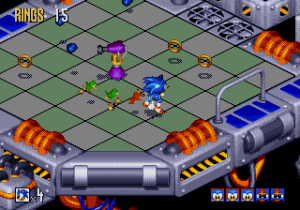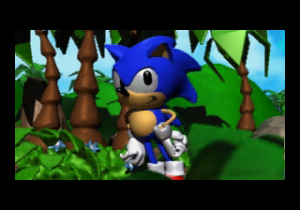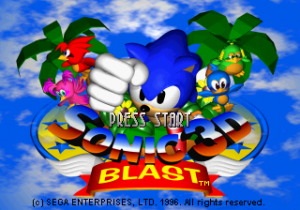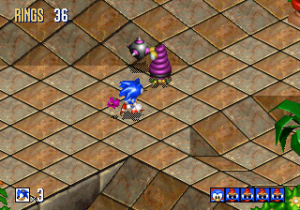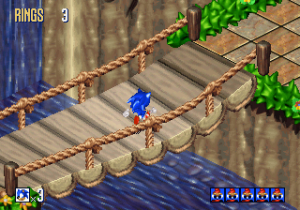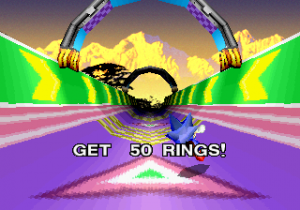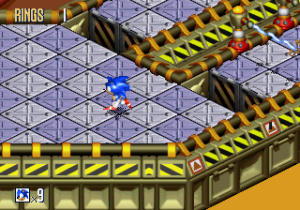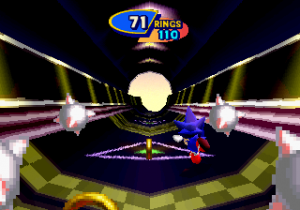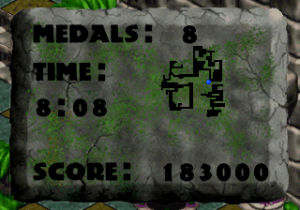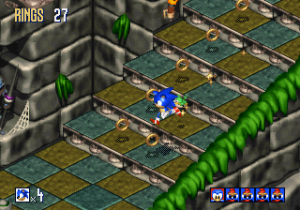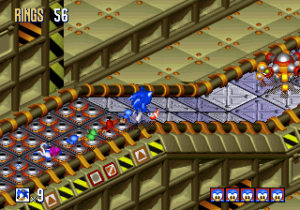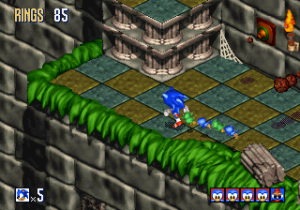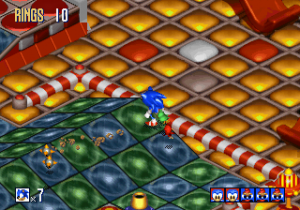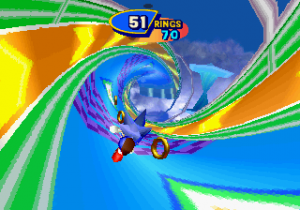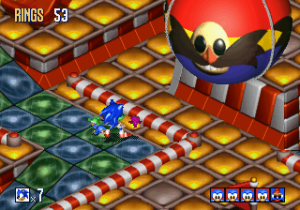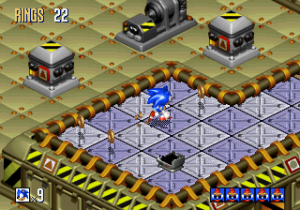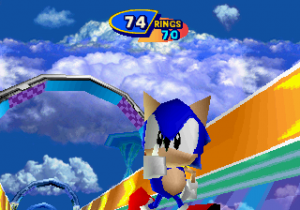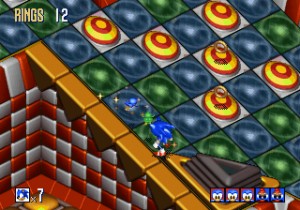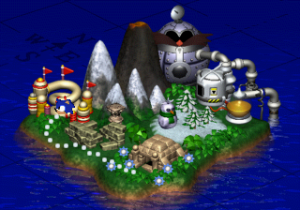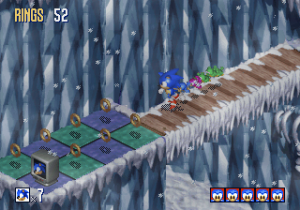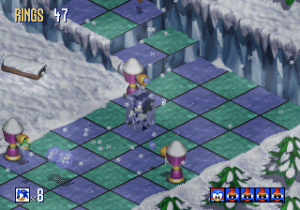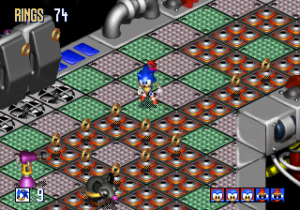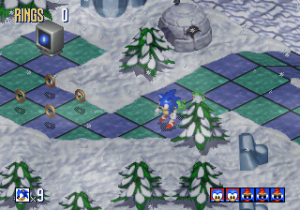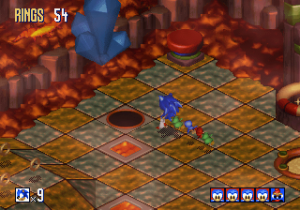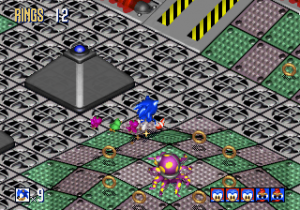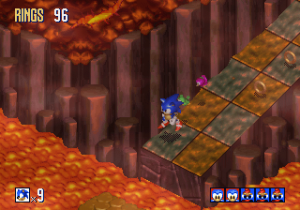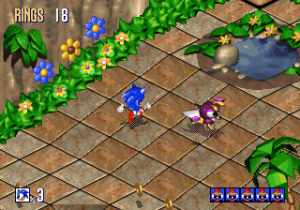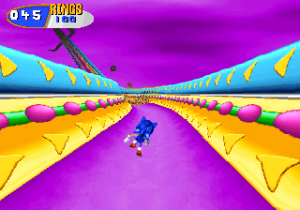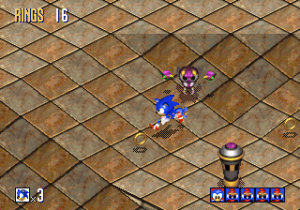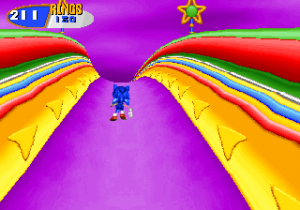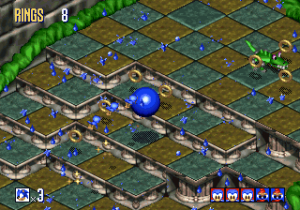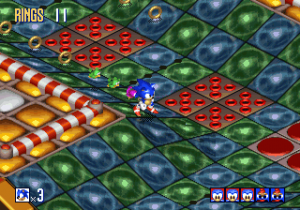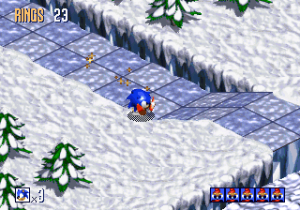- Sonic Generations
- Sonic the Hedgehog
- Sonic the Hedgehog 2
- Sonic CD
- Sonic the Hedgehog 3
- Sonic & Knuckles
- Sonic the Hedgehog 4
- Sonic Mania
- SegaSonic The Hedgehog
- Sonic The Fighters
- Sonic 3D Blast
- Knuckles’ Chaotix
- SegaSonic Bros.
- Sonic the Hedgehog (8-bit)
- Sonic the Hedgehog 2 (8-bit)
- Sonic Chaos
- Sonic the Hedgehog Triple Trouble
- Tails’ Skypatrol
- Tails Adventures
- Sonic Labyrinth
- Sonic Drift
- Sonic Drift 2
- Sonic Blast
- Sonic R
- Murder of Sonic the Hedgehog, The
- Sonic Advance
- Sonic Advance 2
- Sonic Advance 3
- Sonic Rush
- Sonic Rush Adventure
After the release of Sonic & Knuckles in late 1994, Sonic the Hedgehog more or less vanished from the mainstream gaming scene up until the original release of Sonic Adventure in 1998: a period lasting a little over four years. While there were quite a few spin-offs and handheld titles released during that time, only a couple of them were of any real note. One of these games, for better or worse, was the Blue Blur’s swansong on the Mega Drive: Sonic 3D Blast.
Conceptualized by Sonic Team, but otherwise developed by Travellers’ Tales (the studio now known for the many, many Lego franchise games), Sonic 3D Blast was a strange spin-off that mixed elements of isometric games, Sonic’s gameplay mechanics, and the bird-collecting formula from the early-80s arcade game Flicky. Perhaps because of that unusual blend, not many look back on the game fondly, to the point where some consider it to be the premonition of Sonic’s initial failure to adapt to the third dimension (whether or not that’s actually the case will be left up to the reader to decide).
However, when taken as its own game, acknowledging it as a spin-off with whatever quirks and ideas it chooses to run with, Sonic 3D Blast is actually quite an enjoyable game with something unique to offer.
On an island hidden in an alternate dimension, a colorful race of birds called Flickies have the ability to travel anywhere using large rings. Dr Robotnik discovers the Flickies, and decides to capture and turn them into robotic Badniks to help him search for the Chaos Emeralds. On his travels, Sonic ends up on the island and realizes what’s happened, so he sets out to free the Flickies and stop Robotnik. There’s not much to the plot, but it’s interesting how it builds upon the “freeing animals” concept seen in previous games.
Sonic 3D Blast is an isometric platformer, but the core mechanics from the previous Sonic games are retained. You can run, jump, curl into a ball while running to roll into enemies, and charge up a concentrated roll attack from a standstill (known as a Spin Dash). What keeps you alive are rings, which are plentifully dotted about for you to collect – as long as you have even one ring, you can take a hit without dying. You can find protective shields, 10 rings, lives, and other power-ups hidden inside boxes.
But what makes this different from other Sonic games are the Flickies. In each section of a level, there are five Badniks, each one containing a Flicky. When you defeat the enemy, the Flicky is freed and will start to follow you when touched. To move forward, you must find all five Flickies and bring them to the Goal Ring (though you don’t have to bring all of them at once – it just gives you a points bonus). After that, you move onto the next section, and do the same until you get to the end of the level.
In each stage, you can also find Tails and Knuckles hiding in secret areas. If you meet up with them while holding at least 50 rings, you’ll be taken to the Special Stages. These have you collecting a certain number of rings while dodging obstacles, with one of the seven Chaos Emeralds as your reward if you collect enough rings. They’re also the least remarkable part of the game. While the dips and peaks of the psuedo-3D lanes are impressive, the stages are too easy and repetitive to be anything more than a way to get the Chaos Emeralds.
In regards to the gameplay, a misconception that people tend to have about 3D Blast (and other Sonic spin-offs in general) is that because it’s a Sonic game, it must be a speedy, fast-paced rollercoaster ride, and any deviation from that means it must be a bad Sonic game. Ignoring the question of whether the series should be defined by speed alone, 3D Blast is clearly not trying to be that. It’s a slower, exploration-driven game based around collecting and retaining Flickies, and a game that should be judged on its own merits; not by comparison.
With that in mind, it works quite well. The controls take a little bit of time to get used to, particularly when it comes to steep hills where you’ll need quite the run up, but they’re otherwise responsive and allow you to move Sonic easily through the obstacles you’ll encounter. This is backed up by a subtly clever camera that points slightly ahead of whichever direction Sonic is facing, allowing you to see what’s coming up ahead of you. While the isometric perspective can make depth perception, and by extension certain precision platforming segments, quite tricky, the way that everything is cleanly laid out at least helps to orient you.
Exploring the levels to collect the Flickies offers up a different change of pace for the series, with slower levels where you take your time, carefully surveying the levels to find them, and making your way over to the Goal Ring. It’s an enjoyable platformer, although a gameplay choice with mixed results is how all your Flickies scatter away from you when hit, and how you have to run around to get them all back. On the one hand, this forces you to be careful when moving about and makes the levels even more challenging, and therefore satisfying, to beat. But on the other hand, it’s quite annoying to try and find them, since you can easily lose track of where they are, hazard-heavy levels like Volcano Valley make searching for them a pain, and there’s the risk that you’ll get hit again in the middle of your search and have to start over.
The exploration factor is further emphasized with good level design: there are a few routes that offer a couple of different ways to finding each Badnik, you’re rewarded with rings, shields, Special Stage access, and lives if you explore enough to find the many secret areas hidden about, and those power-ups will become important in helping you get through a variety of challenging sections and gimmicks.
This isn’t to say the level design is perfect, however. The placement of the levels in terms of difficulty feels a bit too inconsistent, with Diamond Dust Zone being much easier than the two zones that preceded it, and then being followed up by the frustrating Volcano Valley Zone. As the game reaches to a close, the stages become more and more linear, which makes the second half of the game quite a slog as you’re encouraged to start rushing towards the end.
Enemies and bosses are also something of a problem. While finding the Badniks is a big part of the game, most of them simply march back and forth or leave themselves too open to attack, which makes the linear levels even more dull. The boss battles have rather clever strategies, but shoot themselves in the foot by never changing up their tactics and dragging on for much longer than they should.
3D Blast‘s biggest flaw, and a glaring omission in general, is the lack of a save or password system. Given that each level lasts about 5-7 minutes, and there’s no way to speed through them when you have to collect all the Flickies, this makes quitting the game and getting back to where you left off very frustrating, especially if it means going through that aforementioned second half slog again.
Regardless of what you may think of 3D Blast‘s gameplay, it’s at least got very strong presentation to make the experience more enjoyable. The game is visually gorgeous, with a rounded, pre-rendered art style that still looks unique after so many years. This is accentuated with a clean, attractive color palette that makes it easy to see where everything is, very smooth animation, and a consistent framerate that keeps the gameplay steady and responsive. The game’s programmer, Jon Burton, once spoke about how he had to use every programming trick on the Mega Drive and invent several more to get 3D Blast running, and when you consider how well the game runs (never mind the aforementioned Special Stages and the fact that there’s an FMV intro of all things!), it’s a truly impressive feat.
This is backed up by a (typically for the Sonic series) great soundtrack. The Genesis cartridge music is helmed primarily by Jun Senoue and Tatsuyuki Maeda, the music is comprised of memorable, enjoyable tunes that help to give the levels a certain mood and get players pumped for what’s to come, with cracking songs such as Rusty Ruin and Diamond Dust being among the best of the series’ Mega Drive entries. Little touches like having variations for the second act (which are fully developed, unlike Sonic 3‘s more inconsistent remixes) and stereo mixing to allow for a fuller sound especially help to make this one of the best soundtracks in the series.
Sonic 3D Blast is an interesting experiment, and one with enough flaws that it’s understandable as to why it has a poor reputation amongst some, but it’s nevertheless a enjoyable platformer that offers a different kind of Sonic experience – one that should at least be given a look, instead of being dismissed out of hand for being different.
Like many of the games SEGA developed or published for the Mega Drive, Sonic 3D Blast has been re-released numerous times on several systems. While most of them are emulations of the Mega Drive original, the port for the SEGA Saturn, and to a lesser extent, the pre-Steam Windows release, are the most interesting versions of the game, partially due to their history, but also their differences in presentation.
Originally, the Saturn was planned to receive an original Sonic game for Christmas 1996: Sonic X-Treme, which would not only serve as Sonic’s return to the gaming scene after a couple years’ absence, but as a killer app that would hopefully save the then-middling system. However, the game suffered from an infamously troubled development that lead to many things, including the game’s eventual cancellation and the dissolution of the development team, the SEGA Technical Institute.
As a contingency plan, SEGA commissioned Traveller’s Tales to create a port of Sonic 3D Blast, so that the Saturn could at least have some kind of Sonic game for late ’96. Due to the port’s relatively short turnover of seven weeks, it’s not a hugely different port. The gameplay and level design are exactly the same as the original (and there’s still no save/password system!), with the only major differences coming from the audio-visual presentation and the Special Stages.
The Special Stages, this time designed by Sonic Team, are now fashioned after those from Sonic 2, with various additions such as charge pads, corkscrew loops, springs, platforms, and more to keep you on your toes. While certain obstacles show up a bit too quickly for the player to anticipate, these stages are a huge improvement over the Mega Drive’s, and provide an exciting challenge to change things up.
Unfortunately, the Saturn version has quite a big flaw: long loading times. It can take anywhere from 10-20 seconds for the level to load up (which then have to take that same amount of time to reload should you die), and it can take roughly half that time for even the score tally screen to appear. It really breaks the flow of the game too much to not be noticed, and it can make dying in some of the harder levels/bosses more frustrating than before.
The graphics are quite similar to the original, but there are a few changes made, such as a more realistic color texturing for the floors, weather effects such as snow, haze or mist, and various new details like cute animals, statues or other such things in the background. These changes have mixed results. On the one hand, the weather effects help to give the levels an atmosphere that was lacking in the originals (e.g. Rusty Ruin, Diamond Dust, Volcanic Valley), but the new details only serve to clutter up the levels’ aesthetic and make it difficult to see certain things in time (e.g. Green Grove, Spring Stadium).
The most fondly regarded part of the Saturn version is the soundtrack, and for good reason. Composed by Richard Jacques, who would go on to do the iconic Europop-styled music for Sonic R as well as the Europe exclusive soundtrack to Shinobi Legions, the new soundtrack features a mix of various genres from jazzy to techno pop to rock to orchestral and more, and does a great job at creating unique moods for each level. The music goes for a more ambient feeling, so the melodies aren’t quite as memorable or catchy as the Genesis version, but it’s still a good soundtrack that provides a different, yet equally engaging, atmosphere.
Perhaps that’s the best way to look at the Saturn port of 3D Blast: as a different interpretation of the same game. Both this and the Mega Drive version are equally good; each with specific strengths and flaws that level out in the end; but which one you prefer will largely come down to your personal preferences. If you’re looking for an enjoyable game with catchy music and little-to-no load times, play the Mega Drive original. If you’re more interested in a game full of atmospheric details and Sonic 2-style Special Stages, go for the Saturn port.
Sonic 3D Blast ended up being ported to Windows almost a year later, likely as part of the company’s strategy at the time of porting many of their games to the platform. While this initiative helped to make otherwise relatively obscure games easily playable for a wider market, such as Sonic CD (prior to its 2011 remake), Virtua Fighter (the easiest way to play the original without emulation) and the first Panzer Dragoon, there isn’t much else to say about 3D Blast‘s PC port.
It’s based on the Saturn version, so the graphics and music are much the same (barring certain removed weather effects). The Special Stages have been changed around again, with another take on the Sonic 2 pipes, but these suffer from a blinding color palette where everything bleeds into each other, very poor controls, and more monotonous gameplay than even the Mega Drive’s stages. On a more positive note, the long loading times are completely gone and it’s the only official version of the game to actually feature a save system, but that’s about it.
It’s also worth mentioning this port can be quite the pain to run on modern systems. If you’re interested in playing this version, it’s highly recommended you use the SEGA PC Reloaded program, which has been made to get some of SEGA’s PC ports running much more easily on computers.
Unexpectedly, a fourth version of the game was released years later in 2017, under the title of Sonic 3D Blast: Director’s Cut. Technically, the game is a hack/mod, which takes the original game and alters it to varying degrees in numerous ways. While there are plenty of hacks and mods that exist for Sonic games, what makes this one interesting is that it was developed by Jon Burton, the game’s original programmer.
He made this hack with the intent of addressing common criticisms, while also changing certain things to reflect his own changes on game design philosophies over the years. Although the core bulk of the game remains intact; the level designs are the same, you’re still collecting Flickies, the Special Stages and boss battles are unaltered; the Director’s Cut features numerous gameplay tweaks and additions that make for an altogether different experience.
The controls have been tightened a good deal, which helps in tackling some of the more platform-intensive areas. You only lose one Flicky when hit, and can even find them with the help of a flashing icon that points in their general direction, so gathering lost Flickies is practically a non-inssue compared to the original. The camera has been tweaked for the boss battles so that they can be easily seen by the player, and so on…
However, the biggest changes affect the structure of the game itself. You now have a map screen, and can return to previous levels if you want. You can now only collect one Chaos Emerald per zone, instead of getting them whenever you found Knuckles or Tails, and can unlock the ability to transform into the super-speedy, invincible Super Sonic when you have all of them. There are Sonic medals hiding around each level which, while originally used to gain continues in the original, are now framed as collectibles similar to the Star Coins in the New Super Mario Bros. games.
There’s a time trial mode, where you have no Flickies to find and your goal is to rush to the end of the level as quickly as possible. You now have a percentage counter, with 100% only possible if you not only complete all of the above, but also obtain a collective points total of 5 million. All of these frame Sonic 3D Blast as a collectathon platformer, with a more relaxed and easy-going pace.
This actually serves the core gameplay really well, since it helps to encourage the player to explore the levels and not run straight to the end like a typical Sonic game. It encourages you to replay levels to find those extra secrets, get better times and ring totals, and learn the level layouts inside-and-out (which you’ll certainly need to beat the time trials’ insane time limits – even the first level gives you only 30 seconds to beat it!).
While the exploration driven nature of the game might have conflicted with the original’s linear structure, this new format gives 3D Blast a chance to be appreciated on its own merits, and for those merits to come off more strongly – there’s even a password system to keep your progress intact! However, if you’re not a fan of these changes, there’s an option to play the original version of the game, making the Director’s Cut hack the best way to play Sonic 3D Blast.
Special thanks to ReyVGM for helping me to figure out how to emulate SEGA Saturn games, and to Korama for creating the SEGA PC Reloaded program.
LINKS:
Sonic 3D Blast: Director’s Cut on Steam Workshop – https://steamcommunity.com/sharedfiles/filedetails/?id=1241378226
A playlist of YouTube videos featuring various programming tricks and tidbits about 3D Blast by programmer Jon Burton – https://www.youtube.com/playlist?list=PLBhaF40-OdNiSYz_rRWPxR_EpgKx4J_zO
An interview with Jon Burton discussing 3D Blast’s development and his decision to create the Director’s Cut hack – https://www.eurogamer.net/articles/2018-02-05-why-the-founder-of-travellers-tales-released-a-directors-cut-of-an-old-sonic-game-25-years-later
One of the forum threads where SEGA PC Reloaded was promoted, along with details and download links – https://forums.sonicretro.org/index.php?showtopic=34181
Screenshot Comparisons
